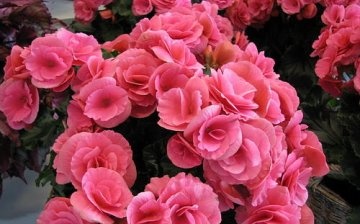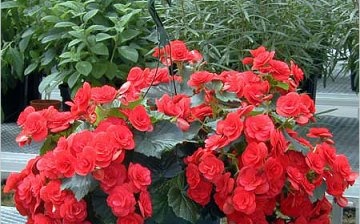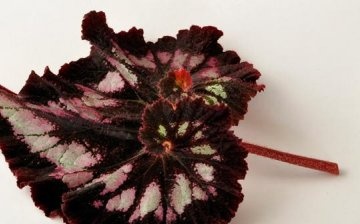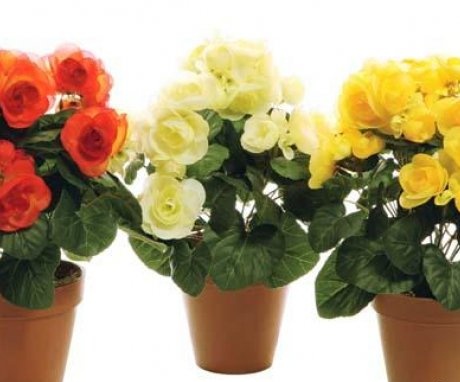Useful tips for flower growers: how to propagate begonia by cuttings correctly
Begonia is a houseplant that belongs to the begonia family. In this family, there are various types of begonias: shrubs, succulents, climbing plants. Africa, America and Asia are considered the birthplace of this plant. The maximum height to which begonias grow does not exceed 100 cm. Almost all species have very succulent leaves, the color of which can be of absolutely any color. Flowers also vary from species to species. The flowering period generally lasts all summer, but in indoor conditions and with proper plant care, begonia can bloom almost all year. There are two types of begonias: decorative flowering, where all the beauty is in the flowers, and decorative deciduous, whose flowers are inconspicuous, and the leaves, on the contrary, attract special attention.
Content:
Types of begonias
In the family of begonias, there are about 1000 species and more than 10,000 varieties of this plant. Many of these varieties and types are used at home. And each kind of begonia is extraordinarily beautiful and unique.
Ever-flowering begonia:
- This is a small dense bush, the height of which can reach 25-30 cm.
- Its branches are herbaceous, juicy, green, usually bare and highly branched.
- The leaves are rounded and about 5 cm wide.
- Dark green with red tint leaves slightly wavy at the edges.
- It blooms in white, red and pink flowers, which can be simple or double.
- The flowering period lasts almost the entire year. Every 3-4 years, the bush must be updated.
- To do this, branches are cut almost to the root, 2-3 viable buds are left on each main branch.
- The cut branches can be rooted in water and planted over the main bush to increase density.
Tuberous begonia:
- Tuberous begonia is an annual shrub plant.
- It has juicy translucent stems, the height of which can reach 60 cm.
- The leaves are decorative, heart-shaped.
- On the sheet itself, thanks to the coloring, a beautiful pattern is visible.
- Leaves can be bare and pubescent.
- It blooms with double flowers, the color of which can be from white to red in any shade.
- This type of begonias is often used for planting in open ground.
- It can often be found in city flower beds and on park lawns in beautiful combinations and patterns.
Royal begonia:
- This type of begonia is bushy.
- The stems of the royal begonia are lying, juicy and pubescent, have a reddish tint.
- The leaves are large, heart-shaped, 30 cm by 20 cm in size, rounded and cut and pointed at the edges.
- The color of the leaves is dark green with a metallic sheen or purple with a metal ring in the center of the leaf closer to the petiole.
- On the underside, the leaf is almost always red in color.
- It blooms with small small flowers 1.5–2 cm in diameter.
- The color of the flowers is white, pink, yellowish.
- Royal begonia prefers moderate temperatures and high humidity.
Chinese begonia:
- Herbaceous bush, whose height is 45 cm.
- The leaves are elongated, heart-shaped, pointed to the ends along the edges of the leaf, there are small denticles.
- The color of the leaves is dark olive with red veins and silvery spots on the upper side, and the leaves are colored red on the lower side.
- It blooms with large flowers, up to 3 cm in diameter, which are collected in 5-8 pieces in a small loose brush.
- The flowering period is early and mid-autumn. The flowers are colored orange and are located on a peduncle, the height of which can be 20 cm.
- For the good development of Chinese begonia, darkened lighting and moderate watering are necessary. Perfect for planting in winter gardens.
Metallic begonia:
- This is one of the tall, bushy begonias, the length of the branches of which can reach 100 cm.
- Stems are reddish, pubescent and highly branched. The leaves are elongated, up to 15 cm in length, oval, serrated at the ends, located on petioles.
- They are painted olive green with a metallic sheen and have red veins, from the bottom of the leaf is completely purple.
- The flowers are small, usually pink in color and slightly pubescent.
Begonia care
Begonias are not particularly whimsical plants and does not require special care... But you need to know a few rules that will help gardeners enjoy the beauty of their plants all year round.
Watering begonias is necessary:
- Moderately, even in summer.
- Waterlogged soil can lead to decay of the root and death of the plant, so it is worth watering when the soil in the pot dries out 2 cm from above.
- But also do not let the soil dry out completely.
- For irrigation, soft, settled water is suitable.
Lighting for begonias needs good, so it is advisable to put it on windowsills where there is no shade. Also begonia does not tolerate direct sunlight. For decorative deciduous varieties of begonias, it is advisable to find a shaded place for the summer.
Begonia should be surrounded by humidified air. This can be done with a special humidifier or simply by placing a container of water near the flower's growth site. You do not need to spray the flower, as stains may appear on the leaves due to excess moisture.
Begonia needs regular feeding for good development and abundant flowering.
For flowering begonias during the period feeding is time the appearance of buds. During this period, it is necessary to apply fertilizers once every 2 weeks. Deciduous begonias are fertilized as needed with nitrogenous fertilizers, which improve leaf growth and strengthen them. For flowering varieties, such fertilization is contraindicated, as it can lead to a decrease in flowering.
Reproduction of begonias
Propagation of begonias by stem and leaf cuttings is one of the simplest ways.
It can also be propagated by seeds, dividing rhizomes and tubers, which is also not difficult and hassle. Spring is a favorable season for breeding.
Reproduction by seeds:
- The seed propagation process begins at the end of winter when the seeds are sown.
- After sowing, they are not sprinkled with earth, since the seeds are very small.
- The seed pot is kept in a room with a temperature of 25 degrees and watered with a spray bottle.
- After germination, the shoots dive several times.
Propagation by cuttings:
- For propagation of begonias by cuttings the upper parts of the branches of the plant or adult leaves in a healthy state are taken.
- Rooting can be done by placing them in water.
- Also, cuttings can be planted in specially prepared soil and, with abundant watering, they also root well.
When propagating by dividing the root and tuber, the plant is taken out of the pot, divided into several parts, and new bushes are planted in pots with prepared soil. This process is carried out in the spring when transplanting plants.
Begonia is a houseplant and breeders are developing new varieties that are more intended for home growing.
Some species with brightly colored leaves or flowers are planted in parks and flower beds. Mainly annual varieties of begonias.
More information can be found in the video.













